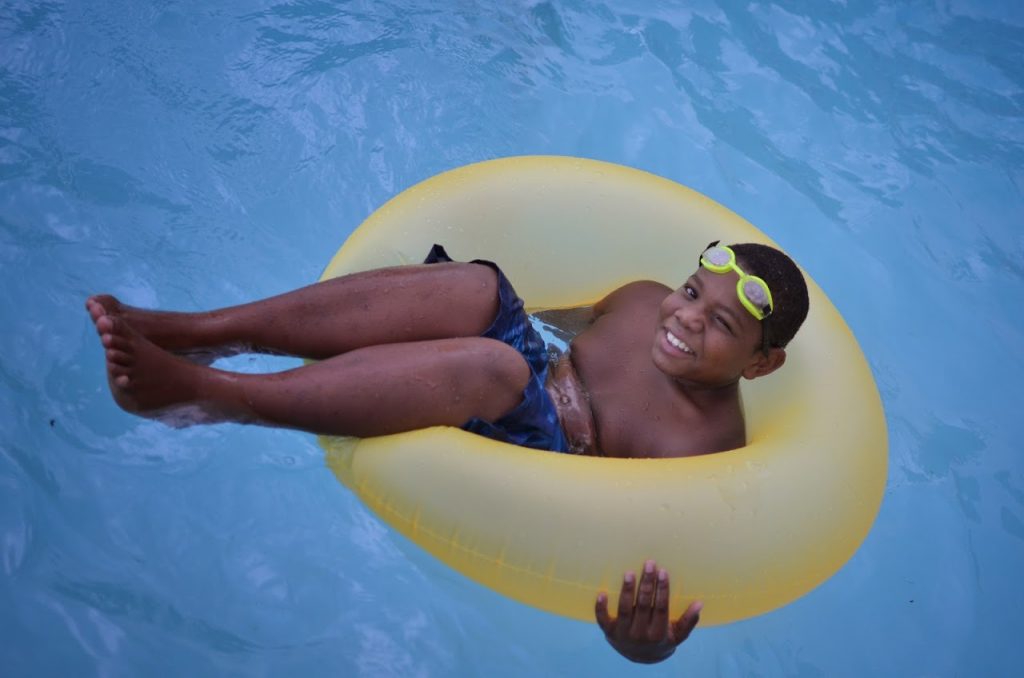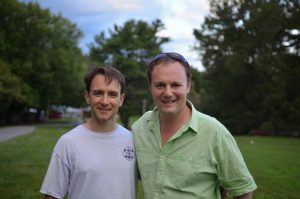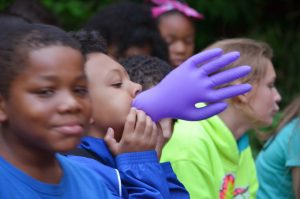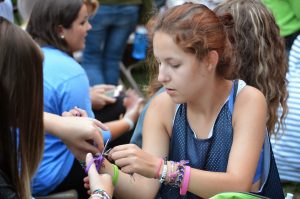
Camp Possibilities, a camp for children with diabetes, was a chance for Andrew Paul Demidowich, MD, and Mihail “Misha” Zilbermint, MD, to learn more about the intricacies of treatment. However, the lessons they took away from their experiences were more than simply treating a disease, it was understanding a lifestyle.
We tried to open the wooden bunk camp door stealthily, but despite our best efforts, its metal hinges made a loud squeal in the cold night. Thankfully, nothing moved, except for the wind and the shadows of our four figures.
We entered, split into teams of two, and went to the first beds on the left as we had planned earlier in the evening. As we changed our headlamps to the red light, so as not to wake any of the children, I tried to make out the name over the bed and make sure it matched the name on the map.
“…as budding endocrinologists, we began seeing young adults with type 1 diabetes more and more frequently in the clinic and inpatient settings. Type 1 diabetes is challenging because of its brittle nature and constant specter of diabetic ketoacidosis or hypoglycemia.” – Andrew Paul Demidowich, MD, endocrinologist, Bethesda, Md.
Feeling like a character out of Mission Impossible, I quietly reached for any exposed finger that I could find, wiped it with an alcohol swab, held my breath, cringed a little, and…“click!” A small drop of blood began to materialize, so I wiped it with a cotton swab, squeezed the finger again, and in the red glow brought the edge of the strip to the droplet. 128 appeared. Whew! I wrote down the value in the log and moved on to the next bed.
Endless Possibilities
Andrew: This was among our first experiences performing a fingerstick on a child with type 1 diabetes. Misha and I had completed our training after medical school as internal medicine physicians and were beginning our second year of Endocrine Fellowship. Our firsthand experience with diabetes was largely treating older adults with insulin resistance and weight problems; we hadn’t treated any children for over seven years, since our pediatrics rotations in medical school.
However, as budding endocrinologists, we began seeing young adults with type 1 diabetes more and more frequently in the clinic and inpatient settings. Type 1 diabetes is challenging because of its brittle nature and constant specter of diabetic ketoacidosis or hypoglycemia. And discussing such a nuanced disease with a patient during a 20-minute clinic appointment is simply not sufficient time for a physician to truly grasp the daily intricacies and challenges that these individuals face. So, when we first heard about Camp Possibilities, a summer camp for children with diabetes, we naturally jumped at the opportunity to join the medical staff.
Located on an idyllic, sprawling private campground in Darlington, Md., Camp Possibilities is a one-week sleep away camp where kids with type 1 diabetes can get the wonderful experience of camp and the great outdoors. Every year about 100 children come and swim, fish, play sports, go on hikes, put on talent shows, and make arts and crafts.
Additionally, they learn about managing type 1 diabetes both from the medical staff and from their peers and counselors, many of whom have diabetes as well. However, it is not a diabetes “boot camp,” but a summer camp where “kids with diabetes can just be kids.” Moreover, there is a large medical staff ever-present, with MDs, NPs, and RNs who are either trained in endocrinology and diabetes, or have type 1 diabetes themselves.
The Highs & Lows of Blood Sugar
The spectrum of symptoms associated with high and low blood sugars is vast.
Misha: As everyone was getting ready for bed one evening, one of my nine-year campers became extremely irritable and even got into an altercation with his fellow cabinmates, which was unusual for him. The counselors asked for help and we were about to call his parents, since camp rules do not tolerate fighting.
(Sung to the tune of “Leaving on a Jet Plane”)
Well my meter is packed and I am ready to go
I’m standing outside by cabin door.
I hate to leave this place and say good-bye.
But the dawn is breakin’, it’s Friday morning
My parents waiting, I am still yawning
Don’t wanna leave, I had an awesome time.
Chorus:
So help me change my pump site,
Make sure it’s positioned right
Dose me so, I’ll never go low.
‘Cause I’m leaving Camp Possibilities
I know that I’ll be back again.
Oh, Jeff, I hate to go.
There are so many times my sugars went down
So many times we ran around
I’m tired peeing on the ketone stick.
Oh, I ate so much, I can barely stand
Two hundred grams? I’ll be dosed again,
When I come back, you’ll love my A1c.
However, knowing that hyper- or hypoglycemia can cause mood changes, I decided to check his sugar: 429 mg/dL. I then checked his urine ketones: moderately high! “Odd,” I thought. “How can he be progressing towards DKA if his insulin pump is in, working, and not giving any error messages about issues with insulin delivery?” We took him to “Club Med” (the medical staff cabin), examined him, had him drink a bottle of water, and administered subcutaneous insulin. I changed his insulin pump site and discovered the cause of his irritability and hypeglycemia — the insertion cannula was kinked!
The boy stopped crying and fell asleep 15 minutes later as his blood glucose started coming down. It was hard to believe that an hour earlier we were considering sending the child home for fighting, a behavior which was likely a result of severe hyperglycemia.
Andrew: My first time witnessing a child with hypoglycemia, for me, I think was just as eye-opening. We were just getting sign-out from the night float team regarding the kids and how their blood glucoses did overnight. All of a sudden, a counselor comes running into Club Med saying that one of the fellow campers wasn’t acting normally. We swiftly went to Cabin 1, adrenaline pumping.
“Almost daily I initiate insulin therapy in my adult patients, who are often reluctant or afraid of injections. I tell them, ‘If my nine-year-olds at the diabetes camp can inject insulin into themselves, I am sure you can do it too.’” — Mihail “Misha” Zilbermint, MD, assistant professor of medicine, Division of Endocrinology, Diabetes and Metabolism, Johns Hopkins University School of Medicine; director, Endocrinology, Diabetes and Metabolism, Suburban Hospital, Bethesda, Md.
The camper was inside, sitting in a chair trying to check his sugar, but due to his tremulousness he simply couldn’t coordinate his movements enough to accomplish it. I took the glucometer from him and helped checked his glucose: 23 mg/dL. Another med staff handed him a juice box and straw, but he tried to “pierce” a nearby roll of duct tape with the straw instead. It was obvious that he was suffering from severe neuroglycopenia and needed glucagon, so another physician quickly injected it into his shoulder.
Amazingly, like a summer squall, this hypoglycemic event disappeared as quickly as it came on, and the camper was smiling and cracking jokes within moments. I breathed a long side of relief and smiled as well. Thankfully I haven’t seen another episode like this in my four years of volunteering at Camp Possibilities, but it hit home that such an event is a daily possibility and a daily fear for these children and their parents.
Every year, more than 400 diabetes programs around the world offer real-life educational experiences for kids with diabetes, as well as adults who want to volunteer. These camps help people affected by diabetes lead healthier, happier, and more productive lives through good diabetes management … and a whole lot of fun!
To find a camp near you or for more information, go to Diabetes Education & Camping Association.
Lullabies at Bedtime
Misha: How can you make sure that a group of high-energy kids goes to sleep? We started singing songs for them after the bed-time snacks and they loved it. I played guitar, Andrew used the table as bongos. We sang American, Russian, Ukrainian, and Hebrew folk songs. I especially enjoyed teaching a song in Russian, “Aliye Parusa” (Scarlet Sails), which I learned as a child years ago in camp. Since we wouldn’t sing without quiet, the kids stopped running around and quickly laid down in their beds to sing along. Pretty soon, the only music was the sound of kids snoring and us quietly walking out of the cabin.
We also had a lot of fun writing lyrics to songs, with camp-related themes. Our best one (we both think anyway) so far has been “Leaving Camp Possibilities” to the tune of “Leaving on a Jet Plane” by John Denver, which was sung by the campers and counselors many times over the next several years (see box).
Sharing Experiences with Patients
Misha: Almost daily I initiate insulin therapy in my adult patients, who are often reluctant or afraid of injections. I tell them, “If my nine-year-olds at the diabetes camp can inject insulin into themselves, I am sure you can do it too.” For an unclear reason, this makes the insulin injections seem much less daunting, and patients are more inclined to initiate insulin therapy.
A Lifestyle, Not a Disease
While the camp was a lot of hard work, being awake and on-the-clock from about 8 am until after the evening med staff meeting finished (about 10 pm), with one overnight call shift during the week, we managed to have lots of fun as well. Between planning evening skits for the talent show, hanging out with the children during mealtimes, judging trivia contests, manning a station at the Camp Carnival, or begging Chet the lifeguard to open the pool for Med Staff pool time, we were always busy and always had smiles on our faces. Most importantly, Andrew and I became best friends.
Needless to say, Camp Possibilities was one of the most valuable learning experiences during our endocrinology fellowship. We had experiences both touching and terrifying, but ultimately it made us better and more compassionate doctors, who understand that diabetes is also a lifestyle, not just a disease.
:





